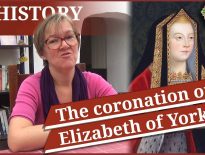On this day in Tudor history, Saturday 24th November 1487, the coronation procession of Elizabeth of York, queen consort of King Henry VII, the first Tudor monarch, took place in London.
Elizabeth of York's coronation was scheduled for the next day. She had become queen in January 1486, but her coronation had been postponed due to pregnancy and trouble with the Cornish rebels and Perkin Warbeck. Finally, Henry VII's wife and the mother of little Prince Arthur could be crowned queen.
Find out all about her coronation procession, what Elizabeth wore, who was involved and what happened, in today's talk.
Also on this day in history:
- 1534 – Death of Sir Thomas Wriothesley, herald and father of the Tudor chronicler Charles Wriothesley. It is thought that he was buried at the family church, St Giles Cripplegate, in London.
- 1542 – The Battle of Solway Moss between England and Scotland. The battle took place on Solway Moss, a moss or peat bog in Cumbria near the Scottish border. The Scottish troops were led by Robert, Lord Maxwell, and the English troops by Sir Thomas Warton. The Scots were forced to surrender after they found themselves trapped between the River Ersk and the moss. Many drowned.
- 1550 – Burial of Sir James Wilford, soldier and commander at Haddington during the War of the Rough Wooing, at St Bartholomew by the Exchange. Bible translator Miles Coverdale preached at the service.
- 1559 – Death of Thomas Raynold, Dean of Exeter and nominee for the bishopric of Hereford. Mary I's death and the accession of Elizabeth I put a stop to him being consecrated as bishop, and he died in Marshalsea prison after refusing the “Oath of Supremacy”. He was buried in St Margaret's Church, Westminster.
- 1572 - The Scottish clergyman, famous Reformer and founder of Presbyterianism, John Knox, died at his home in Edinburgh as his wife read aloud from Paul’s First Letter to the Corinthians. He was buried in the cemetery of St Giles’ Cathedral, Edinburgh, where he had served as minister. Knox is known for bringing the Protestant reformation to the church in Scotland.
- 1587 – Death of Sir William Pelham, soldier and Lord Justice of Ireland, shortly after landing at Flushing in the Netherlands with reinforcements. He had been shot in the stomach in August 1586 at Doesburg while shielding Robert Dudley, Earl of Leicester and his commander in chief, and returned to England in April 1587 to take the waters at Bath. He felt well enough to return to the Netherlands in November 1587, but it was too much for him.
- 1598 – Death of William Paulet, 3rd Marquis of Winchester, nobleman and author, at Basing in Hampshire. He was buried there. Paulet was made a Knight of the Bath at Mary I’s coronation in 1553, and his offices during the reigns of Mary I and Elizabeth included High Sheriff of Hampshire, Commissioner for Musters, Joint Lord Lieutenant of Hampshire, Lord Lieutenant of Dorset and a commissioner at the trial of Mary, Queen of Scots. He was also the author of the 1586 “The Lord Marques Idlenes”, which was dedicated to Elizabeth I, and was described as “containing manifold matters of acceptable advice; as sage sentences, prudent precepts, morall examples, sweete similitudes, proper comparisons, and other remembrances of speciall choice”.
Transcript:
On this day in Tudor history, Saturday 24th November 1487, the coronation procession of Elizabeth of York, queen consort of Henry VII, took place in London. Henry Tudor had become King Henry VII following the defeat of King Richard III at the Battle of Bosworth Field on 22nd August 1485 and he united the Houses of Lancaster and York when he married Elizabeth of York, daughter of the late King Edward IV, on 18th January 1486. Elizabeth gave birth to their first child, Arthur, in September 1486.
Elizabeth’s coronation was postponed due to her pregnancy and then to unrest in the country – the Cornish Rebellion and Perkin Warbeck for example, but was then scheduled for 25th November 1487. On Friday 23rd November 1487, Elizabeth left Greenwich and travelled by water, along the River Thames, to the Tower of London. She was accompanied by her mother-in-law, Lady Margaret Beaufort, Countess of Richmond, and a procession of decorated barges containing peers and peeresses, the Lord Mayor, sheriffs and aldermen. One barge in particular stood out as it carried a red dragon which spouted fire! When she got to the Tower, she was welcomed by her husband the king. Eleven Knights of the Bath were created that night, and then, on this day in history, 24th November 1487, Elizabeth had her coronation procession, processing through the streets of London, from the Tower to Westminster.
The Memoir of Elizabeth York by 19th century historian Nicholas Harris Nicolas, which appears with the Privy Purse Expenses of Elizabeth of York, which Nicolas edited, gives an account of this day drawn from primary sources. I’ll share it with you now.
“[…] On the next day, after dinner, her Majesty being royally apparelled in a kirtle of white cloth of gold damask, and a mantle of the same suit, furred with ermine, fastened before her breast with a great lace, curiously wrought of gold and silk, and rich knobs of gold at the end, tasselled; her fair yellow hair hanging down plain behind her back, with a caul of pipes over it, and wearing on her head a circle of gold, richly garnished with precious stones, quitted her chamber of state. Her train was borne by her sister, the Lady Cecily, and being attended by a great retinue of lords, ladies and others, she entered her litter, in which she was conveyed to Westminster. Most of the streets, which were lined with the city companies in their liveries, were hung with tapestry and arras, whilst in Cheapside, and some other places, rich cloths of gold and velvets and silks were displayed. The houses were filled with spectators, and the crowd is represented as being immense, all eager to see the Queen in her royal apparel, a feeling which had perhaps a deeper source than the gratification of idle curiosity. Children in the dresses of angels and virgins were placed in various parts, who sung the Queen’s praises as she passed; and preceded by the Duke of Bedford as Lord Steward, the Earl of Oxford as Great Chamberlain, the Earl of Derby as Constable, and the Earl of Nottingham as Marshal of England, by the Duke of Suffolk, the Lord Mayor, Garter King of Arms, the Heralds, and other official persons, and by the newly made Knights of the Bath, with their banners borne before them, her Majesty proceeded through the city, sitting in a litter, under a canopy borne by the Knights of the body. Her sister Cecily, her aunt the Duchess of Bedford, the Duchesses of Norfolk and Suffolk, the Countess of Oxford, in two chairs, and six Baronnesses, mounted on palfreys, immediately followed the Queen; and in this order the procession arrived at Westminster, where she slept.”
Elizabeth needed to rest to prepare for the next day, her coronation at Westminster Abbey.



Leave a Reply